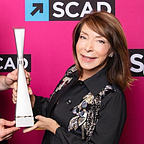What Makes a Great Teacher?
Among the many special joys of my work at SCAD are my frequent interactions with high school educators. I “get it honest,” as my mother would say. Before she became the university’s first admission recruiter, she was a longtime English language teacher and textbook author. It is from my mother that I inherited a special love for high school teachers. I visit with educators at schools like NOCCA and organizations like the Heads Network, and have been known to hand deliver SCAD acceptance letters and meet the teachers who have helped shape these “PreBees.”
After the star-studded SCAD Savannah Film Festival last fall, I received a thoughtful thank-you note from actress Zoey Deutch, recipient of the Rising Star Award. An emerging luminary in the entertainment arts, she produced and starred in The Year of Spectacular Men and took center stage in the recently released Netflix film Set It Up. In her letter, sweet Zoey recounted her own experience attending a performing arts high school — similar to SCAD in its spirit and sense of community. Teachers, she said, were the backbone of that community, providing encouragement and care for young artists who need a place to grow and “space to breathe.”
Zoey’s keen observations about the benefits of an arts education perfectly describe the central role that high school educators play in the success of our university. As a former elementary schoolteacher and a life-long educator, I know that our students — who are blossoming into designers, inventors, storytellers, and tastemakers here at SCAD — deeply treasure the high school teachers who helped nurture them. Every SCAD student has a favorite high school teacher (just as often a math or science educator as art or English). What are the commonalities among these extraordinary teachers? What do they do that makes us love them so, and remember them always?
Great teachers move, often
My mother always said, “A teacher on her feet is worth two in the seat.” Great teachers stand up and migrate to all four corners of the classroom. The benefits are undeniable. The Washington Post recently reported that the best teaching goes far beyond intellectual engagement to include the emotional and physical. If students learn by moving, then so do the most effective instructors.
At SCAD, we encourage professors to see the classroom, not as a classic proscenium (a passive audience, all staring in one direction), but as a more contemporary theater-in-the-round, where the eye and body move. Exploring the room allows teachers to see which students are engaged and who needs a gentle nudge. Most importantly, when teachers traverse the room and share animated facial expressions, students are more likely to interpret those actions as positive and energetic. All teachers were born with bodies. Great teachers use them.
Great teachers motivate
If movement enhances the energy and excitement of students and teachers, imagine what a little motion does for students. I often think of Tilly Beard, my high school Latin teacher. I took four years of Latin! Miss Beard had to be a great motivator, to get us to study a dead language. Yes, she carried us to the National Classical Society Conference and compelled us to recite our declensions, but she also had us wear togas and celebrate the Ides of March like it was Christmas — and translated familiar and popular songs into Latin. She didn’t have to do all that, but she understood her job was to motivate us to learn, to teach ourselves. Though she seemed ancient to her students, her methods were timeless.
I recently reconnected with Melissa Hughey, a former high school art teacher and the very embodiment of motivation. Proof that this technique works, she counts among her former students Olivia West (former Imagineer and now show writer for Universal Creative), Michael Porten (now a contemporary artist featured in the Mercedes-Benz Stadium Art Collection), and Ben Ward (now a SCAD professor of drawing and painting). She taught all three in high school, and all three graduated from SCAD. Motivating educators make motivated graduates.
Great teachers make us feel
The best educators move more than minds; they move hearts. Psychologists refer to the transfer of emotional states as emotional contagion that can cause a ripple effect in groups of people. When harnessed by teachers, this phenomenon is so powerful and effective, filmmakers clamor to transform these stories into Hollywood blockbusters. Think Freedom Writers and Stand and Deliver. The best educators know that they teach students, not subjects, and just like Erin Gruwell and Jaime Escalante (of the aforementioned films), high school teachers across the country are in the unique position to influence children on the precipice of adulthood. They instill values and perceptions, and guide them toward fundamental lessons about life, about their identity, about how they hope to shape their future.
At SCAD, we take pride in our phenomenal 99 percent employment rate, and we share that pride with the high school teachers who continually send us motivated and passionate students — and who have helped build the educational foundation that wins SCAD students and alumni continued success.
More than anything, that foundation is made with love, for that is the universal constant among every great teacher across the centuries: Love for student, love for subject, and love for learning. From the bottom of our hearts, thank you to all the high school educators — and thank you, Tilly Beard. Ammor magnus doctor est! (Love is a great teacher!)
